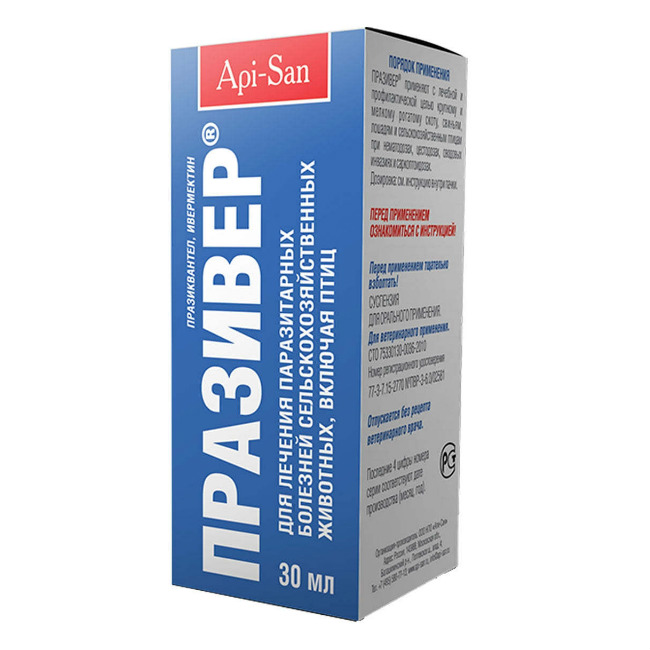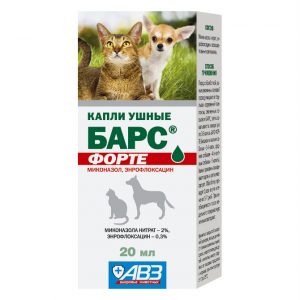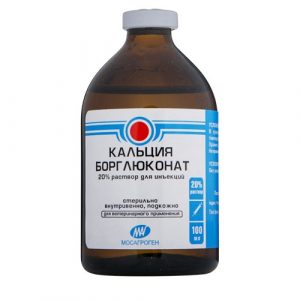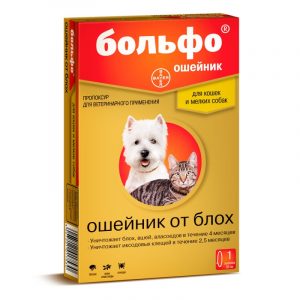Description
Pharmacological action
Praziver belongs to the group of combined antiparasitic drugs.
Praziquantel and ivermectin provide a wide range of antiparasitic actions against prazivera helminths, sarcoptoid mites, insects and gadfly larvae. Praziquantel is a synthetic derivative of isoquinolinopyrazine, active against sexually and immature forms of tape helminths. The mechanism of its action is based on a violation of the permeability of helminth membranes, damage to the outer shell, persistent depolarization of muscle cells, impaired energy metabolism, which causes a generalized contraction of muscles, which turns into permanent paralysis, leading to the death of cestodes. Ivermectin is a compound of the class of macrocyclic lactones, actively against the imaginal and larval phases of the development of nematodes of the gastrointestinal tract and lungs, sarcoptoid mites, insects and gadfly larvae. The main target of ivermectin action is glutamate-sensitive chlorine channels, as well as gamma-aminobutyric acid receptors. A change in the current of chlorine ions through the membranes of nerve and muscle cells disrupts the conduction of impulses, which leads to paralysis and death of parasites. Praziquantel and ivermectin are well absorbed in the gastrointestinal tract, reaching maximum plasma concentrations 4 to 6 hours after oral administration of the drug, undergo biotransformation in the body, excreted mainly in urine, as well as in feces, in lactating animals – partially with milk . According to the degree of impact on the body, the praziver belongs to moderately hazardous substances (hazard class 3 according to GOST 12.1.007-76), at the recommended doses it does not have an embryotoxic, teratogenic and sensitizing effect, toxic to bees, as well as fish and other hydrobionts.
Indications
Praziver is used for therapeutic and prophylactic purposes in large and small cattle, pigs, horses and farm birds with nematodoses, cestodoses, gadfly invasions and sarcoptosis.
Contraindications
Contraindication to use is an increased individual sensitivity of the animal to the components of the drug, including a history of it. The use of Prazivera is not allowed for laying hens, whose eggs are used for food purposes, for repairing young chickens less than 2 weeks before the laying of eggs, to dairy and pregnant females, less than 28 days before delivery, due to the accumulation of the drug in the eggs and excreted in milk, as well as exhausted, sick with infectious diseases and recovering animals.
Composition
Praziver in 1 ml contains as active ingredients: praziquantel – 25 mg and ivermectin – 5 mg and excipients: Na-carboxymethyl cellulose, xanthan gum, potassium sorbate, glycerin, tween-80 and purified water.
Dosage and administration
Praziver is administered orally to animals: to cattle and horses individually, to other species of animals, individually or in groups, in a mixture with concentrated feed. Cattle, horses, sheep, and goats Praziver are used for nematodoses of the digestive tract (hematosis, bunostomiasis, esopha-hostomiasis, nematodirosis, haberthiosis, cooperiosis, ostertagia, strongyloidosis, trichostagiasisosis, lung trichocephaliasis), protostrongiliasis), cestodoses (moniesiosis, avitellinosis, tizaniosiosis), hypodermatosis, gastrophilia, esophagostomiasis and sarcoptosis at a dose of 0.4 ml per 10 kg of animal weight, with estrosis – 0.6 ml per 10 kg of animal weight. With a group method of application, the dose of the preparation, calculated for a group of not more than 100 sheep (goats), is mixed with concentrated feed at the rate of 150-200 g of animal feed. The resulting drug mixture is poured into the feeders, providing animals with free access to them. Treatment of animals against helminths is carried out before stalling and in the spring before pasture on a pasture against gadfly infestations immediately after the end of summer flies – once, with sarcoptosis, psoroptosis and chorioptosis – according to indications twice with an interval of 7 – 12 days. Prasiver pigs are used at a dose of 0.6 ml per 10 kg of animal weight: for nematodoses (ascariasis, esophagostomiasis, metastrongileosis, trichocephalosis, strongyloidosis) – once, with sarcoptosis – twice with an interval of 7-10 days. The dose designed for a group of no more than 50 pigs, they are mixed with half of the feed norm and laid out in feeders, providing animals with free access to them. The broiler chickens, repair young chickens, geese and ducks Praziver are used in case of nematodoses (ganguleteracidosis, ascariasis, heteryracidosis) and cestodoses (drepanidoteniosis, hymenoleptidoses, raietinosis) with a feed of 0.2 ml per morning feed. Before use, the container with the drug must be thoroughly shaken. Before mass treatments, each batch of the drug is tested on a small group of animals (5 ² 7 animals) of different ages and weights. In the absence of complications within 3 days, they begin processing the entire livestock.
Overdose of
In case of drug overdose, an animal may experience depression, refusal to feed, excessive salivation, and indigestion. In these cases, enterosorbents and symptomatic therapy are used.
Storage conditions
Store the drug in the manufacturer ² ¢s sealed packaging, in a place protected from direct sunlight, separately from food and feed, at a temperature of 2 ° C to 25 ° C.
dosage form
oral suspension




